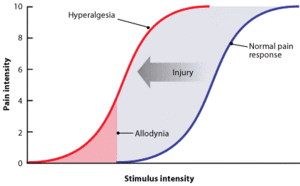Allodynia
Top Contributors - Parker Hall, Melissa Coetsee, Abbi Davis, Jessica Bradshaw, Olajumoke Ogunleye and Kim Jackson
Overview[edit | edit source]
Allodynia is defined as pain resulting from a stimulus, such as a light touch of the skin, that would not normally provoke pain[1]. For example, brushing a feather against the arm causes pain where it should only cause a sensation. Allodynia is categorised into three types:
- Dynamic (or mechanical) when pain results from an object moving across the skin
- Thermal which results from mild temperature changes
- Tactile (or static) which results from gentle touch or pressure.
There is ultimately an error in the nerve communication network.
Aetiology/Mechanism[edit | edit source]
Allodynia is considered a sign/symptom, not a disease. It may be a patient's chief complaint. Allodynia is the phenomenon of a non-painful stimulus producing a pain response, which implies an error in neuronal conduction. The mechanism behind this error is unclear. The strongest evidence that exists, thus far, suggests that sensory neuronal fibres may stimulate pain pathways, possibly due to an error in long-term potentiation. However, some studies suggest that superficial sensory components may also be involved. There is also evidence that different mental states can affect the perception of allodynia.
There is an analogy of "crisscrossed" fibres, where the actual location of the crisscrossing can vary and may be located almost anywhere along the peripheral to the central nervous system tract. Allodynia can involve both the peripheral nervous system and central nervous system via sensitisation, and the mechanism behind the inappropriate pain sensations can evolve. This might partially explain the existing contradictory studies - they may all be measuring allodynia with neuronal confusion at different locations[2]. The expression of allodynia may be as elegantly simple as a consistent increase in sympathetic nervous system activity, which leads to a sensitisation of C-fibres. The increase in C-fibre sensitisation is also a reflection of disinhibition of secondary spinal networks[3]. In other words, a loss of spinal segregation of touch and pain can be a key mechanism of allodynia[4].
Listed below are some of the most common diseases associated with allodynia:
- Fibromyalgia
- Trigeminal Neuralgia
- Diabetic Neuropathic Pain
- Migraine Associated Allodynia
- Neuropathic Pain
- Central Sensitisation
- Peripheral Sensitisation
- Complex Regional Pain Syndrome (CRPS)
- Chronic Low Back Pain
- Postherpetic Neuralgia
- Osteoarthritis
Differential Diagnosis[edit | edit source]
Another sensory condition that is often a differential diagnosis to allodynia is hyperalgesia. Hyperalgesia is the condition of having increased sensitivity to pain or enhanced intensity of pain sensation[5]. Patients do not necessarily perceive high pressure as pain, but the stimulus that would normally be perceived as low pain is sensed at a higher pain level. Patients respond to pain stimulus in the same way that they would if they did not have the condition, but it is an exaggerated response[2].
Treatment[edit | edit source]
There are multiple ways that healthcare providers can help treat allodynia. Providers can either treat the condition that is causing allodynia or try to reduce the pain.
- Medication: Anticonvulsants (used to treat seizures), triptans (used to treat migraines), and some antidepressants. Topical creams that can help manage allodynia will typically have lidocaine or capsaicin as the active ingredient.
- Psychosocial interventions: Counselling may be recommended if signs of depression are detected. Biofeedback, mindfulness training, and cognitive behavioural therapy can change the way a person responds to pain.
- Physiotherapy: The psychologically informed physiotherapist can include pain neuroscience education (PNE) and cognitive functional therapy. Physiotherapist can help manage allodynia with desensitization and/or mirror therapy.
- Other procedures: A nerve block injection may be recommended to reduce pain in a specific nerve or nerve group.[6]
Prevention[edit | edit source]
Allodynia can not be directly prevented, however, one can lower the risk of acquiring a condition that causes allodynia. Risk management includes exercising regularly, monitoring health, managing mental health , maintaining a healthy weight, having a balanced diet, and having good sleep hygiene.
References[edit | edit source]
- ↑ Definition of ALLODYNIA [Internet]. Merriam-webster.com. 2017 [cited 2022 Apr 9]. Available from: https://www.merriam-webster.com/dictionary/allodynia
- ↑ 2.0 2.1 He Y, Kim PY. Allodynia [Internet]. PubMed. Treasure Island (FL): StatPearls Publishing; 2016 [cited 2022 Apr 9]. Available from: https://www.ncbi.nlm.nih.gov/books/NBK537129/
- ↑ Kuner R. Central mechanisms of pathological pain. Nature medicine. 2010 Nov;16(11):1258-66.
- ↑ Kuner R, Flor H. Structural plasticity and reorganization in chronic pain. Nature Reviews Neuroscience. 2017 Jan;18(1):20-30.
- ↑ Medical Definition of HYPERALGESIA [Internet]. www.merriam-webster.com. [cited 2022 Apr 9]. Available from: https://www.merriam-webster.com/medical/hyperalgesia
- ↑ Cleveland Clinic. Allodynia. [cited 2022 Apr 8]. Available from: https://my.clevelandclinic.org/health/symptoms/21570-allodynia







